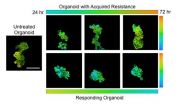(Press-News.org) SAN FRANCISCO: A simple intervention designed to raise awareness about the use of communication devices while driving reduced the incidence of distracted driving by 50 percent in hospital personnel, according to findings from a single site study presented today at the 2014 Clinical Congress of the American College of Surgeons.
Driving distracted–caused by any activity that steals a driver's attention from the road–is at an all-time high. In 2012, an estimated 421,000 people were injured in accidents involving distracted driving and 3,328 were killed as a result of it, according to the National Highway Transportation Safety Administration (NHTSA).*
"There is no doubt that this activity is a serious danger and one of the largest growing killers in our world," said senior study author Bellal Joseph, MD, FACS, a trauma surgeon and associate professor of surgery at the University of Arizona, Tucson. "People have a lack of insight about the true dangers of texting and driving. They know it's not safe, but they really don't understand the high level of peril it truly represents."
In an effort to identify the incidence of distracted driving among health care providers at the University of Arizona and to raise awareness about its hazards, study authors conducted a four-phase intervention. The aim was to assess the incidence of distracted driving among health care personnel and assess the impact of prevention campaign on incidence of distracted driving.
In the first phase, researchers observed the incidence of distracted driving–talking on a cell phone or texting behind the wheel–of hospital employees. To do this, they stationed themselves outside an employee parking garage where nursing staff and doctors exit the hospital. Staff members were identified by the display of car passes, or the wearing of hospital badges, and/or scrubs. Incidence of distracted driving was recorded in three intervals, each day for one week.
The second phase consisted of a survey and a five-point educational intervention. For the survey, hospital employees received a questionnaire about their overall knowledge of distracted driving as well as their driving habits, including whether or not they texted or used a cell phone while driving.
For the intervention, researchers explained to respondents why using handheld devices while driving is dangerous; for instance, using a cell phone on the road is equivalent to driving with a blood alcohol level of 0.08 percent, or being legally impaired. What's more, five seconds is the average time texting steals a person's attention from the road. When traveling at 55 mph, that's like traveling the length of a football field blindfolded.*
Meanwhile, researchers posted banners in the hospital cafeteria and handed out informational brochures about distracted driving. Afterward, a post-intervention questionnaire was given to survey respondents to find out how many were affected by what they had learned.
For phase three, researchers returned to the hospital parking lot where they once again observed and recorded the driving habits of hospital employees for another week. After six months, respondents were sent a post intervention follow up survey.
Overall, researchers collected 15,316 observations (pre-intervention: 6,639; post-intervention: 4,220; post-intervention six months: 4,557) and 520 survey responses. The investigators found that 35.5 percent of respondents admitted to driving distracted while 4.5 percent were involved in a wreck because of it. Additionally, 77 percent of respondents felt more informed after the survey and 91 percent said they supported state legislation against distracted driving.
Additionally, the researchers found a 50 percent decrease in distracted driving after the intervention and this reduction held even after six months.
"A lot of people admitted to distracted driving, but the real key is that 60 percent said they would stop using their cell phones after the intervention, 50 percent said they would change their habits and 51 percent said they had a new understanding of how dangerous distracted driving is," Dr. Joseph reported.
Even simple activities such as talking or changing the radio station can pull a driver's attention away from the road long enough to cause a car accident. Data from NHTSA indicate that nearly 80 percent of all motor vehicle accidents involve driver inattention within three seconds of the crash.*
"This study shows that a big part of trauma care is injury prevention. If we don't get out there and educate people and even push for legislation against it, this dangerous trend is going to continue to grow. It's not going to get any better," Dr. Joseph said. "We are looking to start a DADD, doctors against distracted drivers, and initiate a big push for a national outreach campaign against distracted driving."
INFORMATION:
Additional authors include Bardiya Zangbar, MD; Viraj Pandit, MD, MBBS; Narong Kulvatunyou, MD, FACS; Sandeep Bains MS; Andrew Tang, MD, FACS; Terence O'Keeffe, MBchB, FACS; Donald J. Green, MD, FACS; Randall S. Friese, MD, FACS; and Peter Rhee, MD, FACS.
*Source: 100-Car Naturalistic Driving Study. National Highway Transportation Safety Administration. Available at: http://www.nhtsa.gov/About+NHTSA/Press+Releases/2006/100-Car+Naturalistic+Driving+Study, Accessed October 1, 2014.
A population of endangered giant tortoises, which once dwindled to just over a dozen, has recovered on the Galapagos island of Española, a finding described as "a true story of success and hope in conservation" by the lead author of a study published today (Oct. 28).
Some 40 years after the first captive-bred tortoises were reintroduced to the island by the Galapagos National Park Service, the endemic Española giant tortoises are reproducing and restoring some of the ecological damage caused by feral goats that were brought to the island in the late 19th century. ...
New Haven, CT, Oct. 28 2014 – Each year, malaria kills over 600,000 people, more than half of them children. In a study published today in PLOS ONE , researchers with the non-profit Innovations for Poverty Action (IPA) and Harvard University found that simple text message reminders to take malaria medication can help in the fight against the disease by boosting the rates at which patients complete their medication regimen.
One challenge in fighting malaria is that the disease has evolved resistance to many drugs that formerly worked, according to Julia Raifman, ...
This news release is available in German.
In addition to their song, songbirds also have an extensive repertoire of calls. While the species-specific song must be learned as a young bird, most calls are, as in the case of all other birds, innate. Researchers at the Max Planck Institute in Seewiesen have now discovered that in zebra finches the song control system in the brain is also active during simple communication calls. This relationship between unlearned calls and an area of the brain responsible for learned vocalisations is important for understanding the ...
JUPITER, FL, October 28, 2014 – Scientists from the Florida campus of The Scripps Research Institute (TSRI) have uncovered a major contributor to Huntington's disease, a devastating progressive neurological condition that produces involuntary movements, emotional disturbance and cognitive impairment.
Using an animal model of Huntington's disease, the new study shows that signaling by a specific protein can trigger onset of the disease and lead to exacerbation of symptoms. These findings, published in the October 28, 2014 issue of the journal Science Signaling, offer ...
A connection between inflammation and cancer has been recognized for over a hundred years. This connection is particularly evident in colon carcinogenesis, because patients with IBD have a higher incidence of colon cancer than the general population. There is increasing evidence that inflammation contributes to the earliest stages of carcinogenesis, namely in the process of cell transformation, where the cell acquires many aspects of cancer characteristics. The observation that IBD and colon cancer incidence rise as nations industrialize suggests that changes in diet and ...
PROVIDENCE, R.I. [Brown University] — New research by physicists from Brown University puts the profound strangeness of quantum mechanics in a nutshell — or, more accurately, in a helium bubble.
Experiments led by Humphrey Maris, professor of physics at Brown, suggest that the quantum state of an electron — the electron's wave function — can be shattered into pieces and those pieces can be trapped in tiny bubbles of liquid helium. To be clear, the researchers are not saying that the electron can be broken apart. Electrons are elementary particles, ...
Politics can have unintentional evolutionary consequences that may cause hastily issued policies to cascade into global, multigenerational problems, according to political scientists.
"Most western democracies look at policies as if they are bandages, we fix what we can and then move on," said Pete Hatemi, associate professor of political science, Penn State. "But we need to consider generational policies so that we can fix what we can now, but also be prepared for what comes next."
The researchers said that there is an interaction between political and cultural forces ...
WASHINGTON, D.C., October 28, 2014 – In the future, computers may be capable of talking to us during meetings just like a remote teleconference participant. But to help move this science-fiction-sounding goal a step closer to reality, it's first necessary to teach computers to recognize not only the words we use but also the myriad meanings, subtleties and attitudes they can convey.
During the 168th Meeting of the Acoustical Society of America (ASA), to be held October 27-31, 2014, at the Indianapolis Marriott Downtown Hotel, Valerie Freeman, a Ph.D. candidate in ...
One of the tragic realities of cancer is that the drugs used to treat it are highly toxic and their effectiveness varies unpredictably from patient to patient. However, a new "tumor-in-a-dish" technology is poised to change this reality by rapidly assessing how effective specific anti-cancer cocktails will be on an individual's cancer before chemotherapy begins.
A team of biomedical engineers at Vanderbilt University headed by Assistant Professor Melissa Skala has developed the technique, which uses fluorescence imaging to monitor the response of three-dimensional chunks ...
Tropical Cyclone Nilofar developed an eye on Oct. 28 that seemed to stare at NASA's Terra satellite as it passed overhead in space. Warnings are already in effect from the India Meteorological Department as Nilofar is forecast to make landfall in northwestern India.
On Oct. 28 at 06:50 UTC (2:50 a.m. EDT) the MODIS instrument aboard Terra captured a visible image of Tropical Cyclone Nilofar after it developed an eye while moving north in the Arabian Sea. The 12 nautical mile (13.8 miles/22.2 km) wide eye was surrounded by powerful thunderstorms and bands of thunderstorms ...




